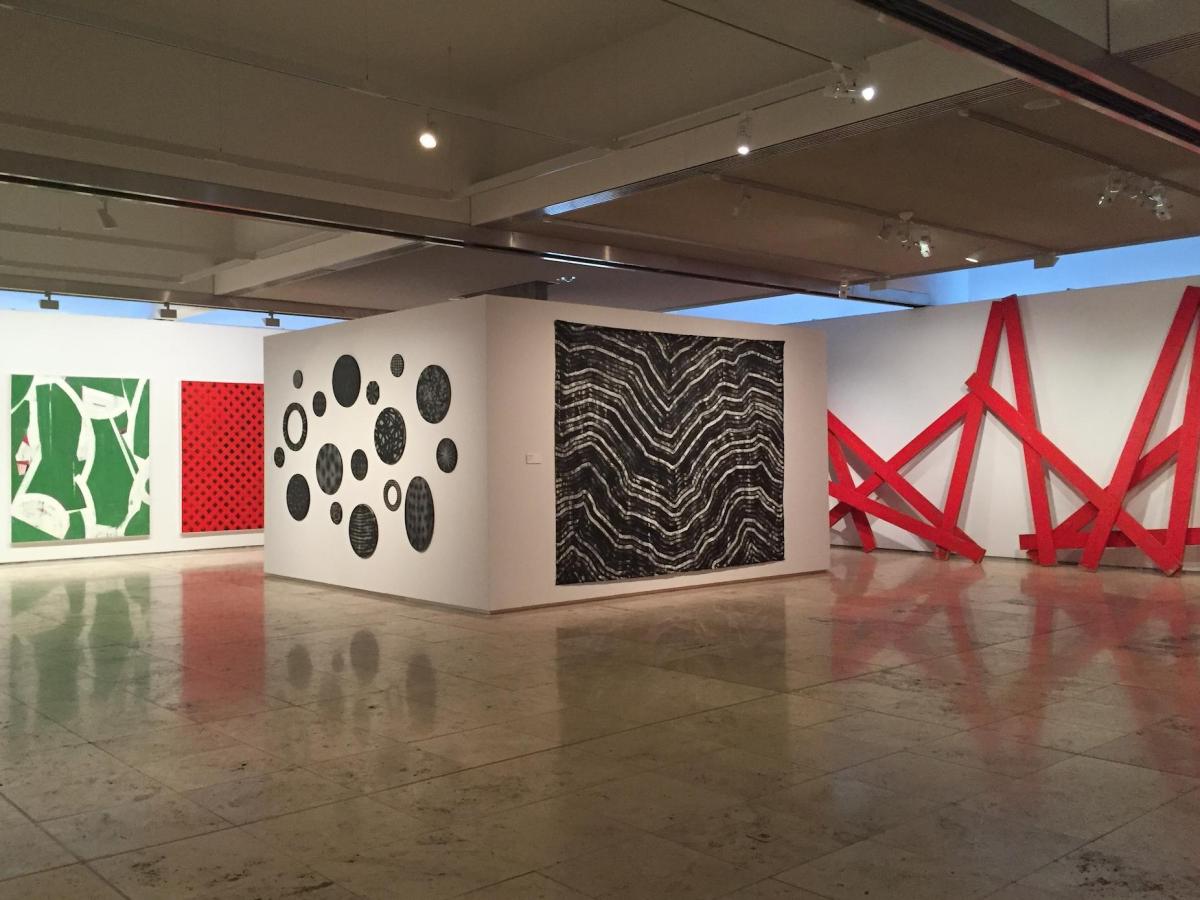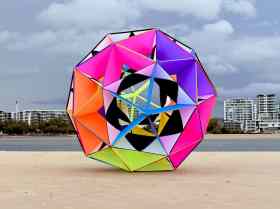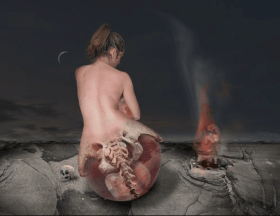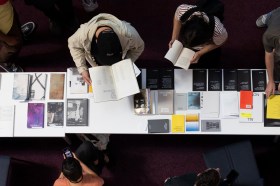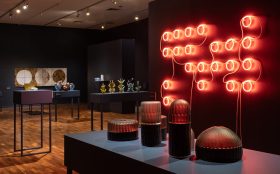Installation view Brett McMahon’s Distillation exhibition, Newcastle Art Gallery; Photo ArtsHub.
This is a show about drawing. Sounds simple, but it is far from that. Newcastle based artist Brett McMahon strips bare his career of the last fifteen years, distilled to the recurring power of the drawn mark.
How that mark appears is the journey the viewer takes with McMahon. One moves from the subtle gesture of ink on paper or a veil of gesso sitting on raw jute that floats off the gallery wall, to a robust conversation in timber planks, as standard 4×2’s demarcate and describe space as bold red lines.
Drawing is not only about materiality – drawing is limitless in McMahon’s imagination.
In the past McMahon has quickly been package up as an abstractionist – dare we even say a formalist – and in so doing has denied the kind of autobiographical reading of the Novocastrian landscape that sits at the core of his work. These are very intimate and personal marks that have a place. They describe the memories of industrial architecture as a child, the eroded rock platforms and bleached salty shores that have been a constant for McMahon, and the coastal Awabakal bush that became a studio for his making.
What McMahon does is open our eyes, as viewers, to the rich vocabulary of our everyday surroundings. The morning after viewing this exhibition I walked the Newcastle coastline. My eye kept falling on details described in the exhibition, like sample tiles or a dictionary of references – Brett was everywhere.
It was a micro macro engagement – a permeation – so eloquently described by McMahon in his After Nature series (2011). In this series, paper itself becomes the medium – sanded, sprayed, crumpled, punctured, weathered – taking on the character of the landscape rather than a description of it.
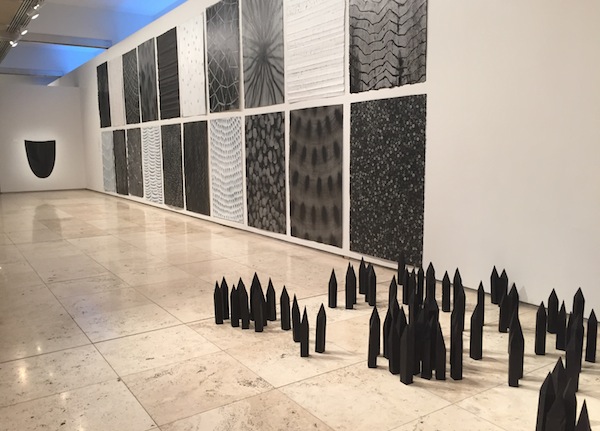
Installation view of After Nature with Colony in the foreground; Brett McMahon’s Distillation exhibition, Newcastle Art Gallery; Photo ArtsHub.
Arranged in a grid formation the action and mark fuse in a poetic study. It is bold and confident and probing. It almost has an aural quality to it – you can hear the wind whipping across its surface caught in the eddies of gesture; the roll of the sea and the creak of industry offering punctuations across the series. Something so simple becomes so articulate.
The twenty works in the series have been further reduced to a minimal palette range of black and white. It again reminds us of this exhibition’s title Distillation; to find the potency or truth in the most elemental.
After Nature is book-ended by sculptural pieces – Colony (2014) is a floorpiece of spike-like shards made from ubiquitous boundary markers from a hardware store, while Thorns (2013) is a wall piece of nine immaculately crafted forms that literally protrude from the gallery wall with surreal insistence. Their pristine fabrication sits beautifully in contrast to the abraded After Nature drawings; the natural and the man-made blur and jar and, yet, they’re held in conversation through vague familiarity.
McMahon’s dexterity to take the drawn mark off the page and play with it spatially finds a crescendo in two resolved sculptural pieces in the exhibition.
Flood fence (2014) was made in the same year as Colony but is a more raw material play, as frayed string, rope, and debris are poetically drawn along the gallery in a slumped line. McMahon flirts with notions of weight, repetition and form, the positioning of the wall-based sculpture having a very physical or bodily engagement with the viewer. We become entangled in its curious beauty, but also unsettled by its reminder of nature’s power, prompted in the work’s title.
It has a wonderful conversation with an adjacent suite of works on paper, Awabakai 1-5 (2007), that help stitch the connections across this exhibition for the viewer.
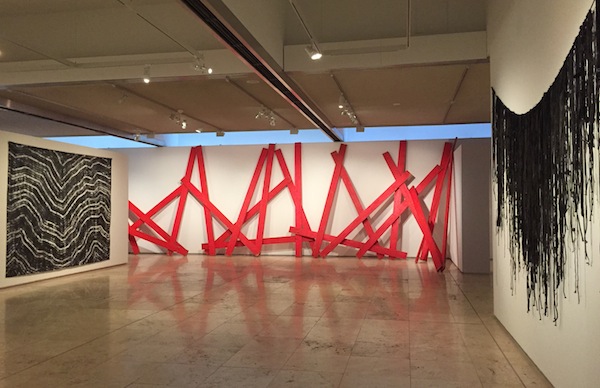
Installation view Brett McMahon’s Distillation exhibition, Newcastle Art Gallery; Photo ArtsHub.
The centerpiece of the exhibition – despite is presentation in an almost adjust corner playing with the gallery’s architecture – is the large 3-dimensional drawing, Drawing 1 – Ariel (2015), a new work of 25 pieces of wood planks painted red. There is something heroic about this work in its simplicity and surety. For me, it is almost a metaphor for Newcastle’s resilience in the light of BHPs closure.
Again, it reminds us how cohesive and well hung this exhibition is. The installation reaches and connects across the space making sense of, and expanding in a renewed conversation with, McMahon’s Industrial structures series (2006), six large paintings that hold the back wall of the gallery space. Near a decade apart McMahon’s focus reads as unwaivering.
This bounce across time – and a consistency and commitment of vision – is the strongest walk away from this exhibition. It is a trait not always found in a survey show, which so often are just about celebrating volume in one’s career.
Walking into this exhibition we are offered almost a haiku to its ethos. A smallish gestural abstraction on paper City Drawing (2002) – the first work acquired by the Newcastle Art Gallery of McMahon’s work – was paired with Bleach (2015), fresh out of the studio. It was a large painting pinned, floating off the wall; its raw heavy linen breathing through a veil of gesso.
Time is contracted into a moment. It is clearly grasped in all its dimensions, layers, and expressions. McMahon gives us time in this exhibition, and in our world of manic speed, it is a gift indeed to just get lost in those drawn moments.
Rating: 4.5 out of 5
Distillation: The art of Brett McMahon
Newcastle Art Gallery
13 June – 30 August 2015
Join Sebastian Smee, Australian Pulitzer Prize-winning art critic for The Boston Globe, for an insightful talk and Q&A session with Brett McMahon, Friday 21 August 6.00 – 8.00pm. This is a ticketed event.
